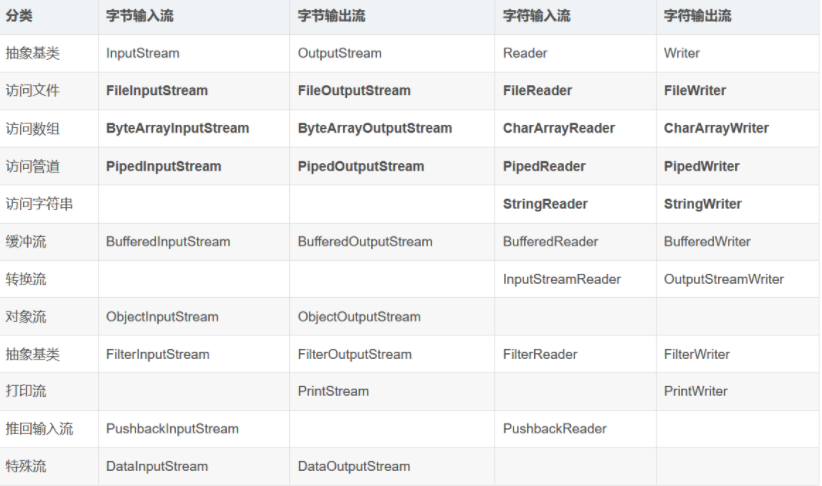[TOC]
Java基础语法 IO流核心(读进来,写出去)
一、IO流存在的意义
解决设备与设备之间的数据传输问题,比如:硬盘——->内存 内存——–>硬盘。
计算机进行网络数据传输,文件读写,用户输入和打印的时候都需要用到IO流。
二、IO流分类
Java IO流共涉及40多个类,这些类看上去很杂乱,但实际上很有规则,而且彼此之间存在非常紧密的联系,Java IO流的40多个类都是从如下4个抽象类基类中派生出来的。
InputStream/Reader: 所有的输入流的基类,前者是字节输入流,后者是字符输入流。
OutputStream/Writer: 所有输出流的基类,前者是字节输出流,后者是字符输出流。
注:它们都是一些抽象基类,无法直接创建实例。

三、字符流和字节流
字符流的由来: 因为数据编码的不同,而有了对字符进行高效操作的流对象。本质其实就是基于字节流读取时,去查了指定的码表。 字节流和字符流的区别:
- 读写单位不同:字节流以字节(8 bit)为单位,字符流以字符为单位,根据码表映射字符,一次可能读多个字节。
- 处理对象不同:字节流能处理所有类型的数据(如图片、avi 等),而字符流只能处理字符类型的数据。
结论:只要是处理纯文本数据,就优先考虑使用字符流。 除此之外都使用字节流。
四、输入流和输出流
对输入流只能进行读操作,对输出流只能进行写操作,程序中需要根据待传输数据的不同特性而使用不同的流。
五、IO流常用读写操作
==使用字符流复制文件==
//使用字符流复制文件 public class Test{ public static void main(String[] args) throws IOException { try(BufferedReader br = new BufferedReader(new FileReader("E:\\Test1.txt")); //通过文件缓冲流读文件 BufferedWriter bw = new BufferedWriter(new FileWriter("E:\\Test2.txt"))) { char[] ch = new char[100]; int len; while((len = br.read(ch))!=-1) {//以一个字符数组为中介存储或者读写东西,也有防止数组浪费的好处 bw.write(ch); } } catch (FileNotFoundException e) { // TODO Auto-generated catch block e.printStackTrace(); } } }==字节流复制数据==
public class Test{ public static void main(String[] args) throws IOException { BufferedInputStream bis = new BufferedInputStream(new FileInputStream("E:\\Test3.jpg")); BufferedOutputStream bos = new BufferedOutputStream(new FileOutputStream("E:\\Test4.jpg")); byte[] b = new byte[1024]; int len; while((len = bis.read(b))!=-1) {//字符流通过字符数组,字节流当然通过字节数组 bos.write(b); bos.flush(); } bos.close(); bis.close(); }==字符和字节的转换==
public class Test{ public static void main(String[] args) { //字符串 a c v String str1 = 12 + ""; //String str2 = 'a' + ""; //将字符串转换成字节数组,可以输出一下更好理解流的本质 byte[] bytes = "abc".getBytes(); for (int j = 0; j < bytes.length; j++) { System.out.println(bytes[j]); } //有参构造 将字节数组 编程 字符串 String str = new String(bytes); //重写了toString 打印字符串的内容 System.out.println(str.toString()); } }==查找后缀名是 .txt 的文件==
public class Test{ public static void main(String[] args) { getDir("F:\\", ".txt"); } public static void getDir(String path,String latter) { File f = new File(path); if(f.isFile()) { //如果是文件的话就可以输出路径 if(f.getName().endsWith(latter)) { System.out.println(f.getAbsolutePath()); } } else { File[] list = f.listFiles();//不是文件的话必须得深入文件夹去查看 if(f.length()>0&&list!=null) { for (File file : list) {//遍历文件夹中的东西 getDir(file.getAbsolutePath(), latter); } } } } }==删除某一个文件 (和查找相似)==
public class Test{ public static void main(String[] args) throws IOException { removeDir("F:\\practice"); } public static void removeDir(String path) throws IOException { File file = new File(path); if(file.isFile()) { file.delete(); } else { File[] listFiles = file.listFiles(); for (File file2 : listFiles) { removeDir(file2.getAbsolutePath()); } file.delete(); } } }==一个项目中的实例某一块运用==
public static void main(String[] args) { List<ShoppingBean> list = new ArrayList<>(); try(BufferedReader br = new BufferedReader(new FileReader("D:\\a.txt"));) { String str; while((str=br.readLine())!=null) { //可以一行一行读取 String[] split = str.split(","); int id = Integer.parseInt(split[0]); String name = split[1]; double price = Double.parseDouble(split[2]); int number = Integer.parseInt(split[3]); ShoppingBean bean = new ShoppingBean(); bean.set(id, name, price, number); list.add(bean); } } }==解决乱码问题,看源代码是什么编码,使用包装类解决==
public void downLoad() throws IllegalArgumentException, IOException { FSDataInputStream input = fs.open(new Path("/upload.txt")); BufferedReader br = new BufferedReader(new InputStreamReader(input,"utf-8")); //使用包装类修改编码 BufferedWriter bw = new BufferedWriter(new FileWriter("e:/upload.txt")); String str = null; while((str = br.readLine())!= null) { bw.write(str); } bw.close(); br.close(); }



